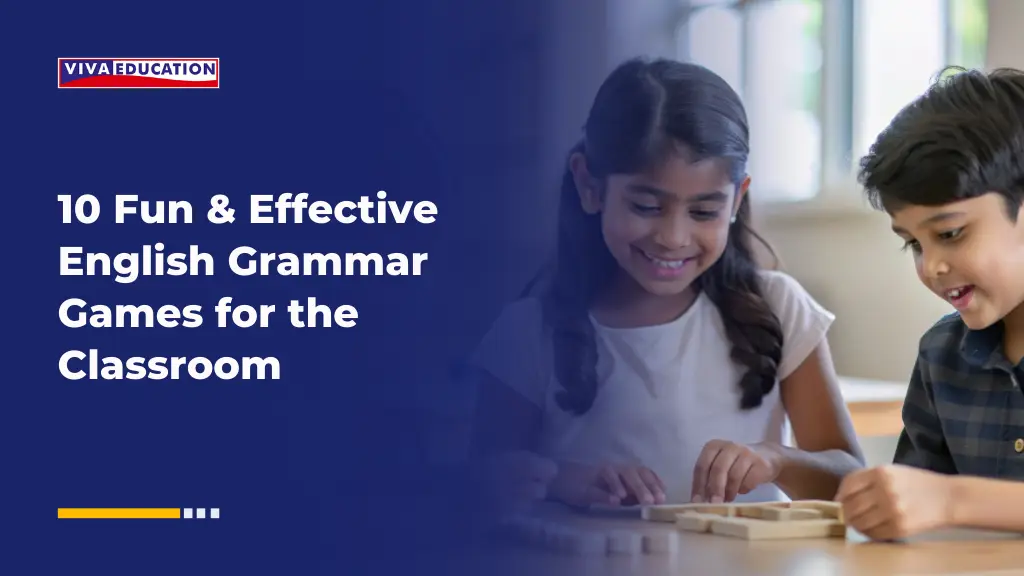10 Fun & Effective English Grammar Games for the Classroom
- Teachers
- April 18, 2025
- Viva Education

Grammar is the backbone of any language, providing communication structure, clarity and meaning. Yet, for many students, learning grammar feels like trudging through a never-ending maze of rules, exceptions, and textbook exercises. Teachers often find it challenging to keep young minds engaged when faced with passive worksheets or monotonous drills.
But what if grammar lessons didn’t have to be dull?
We all know that games make everything more exciting so why not bring that same energy into grammar lessons? These interactive English grammar games for students reinforce key concepts, giving students the chance to use grammar in context, build their confidence, and develop real-world communication skills.
In this article, we explore 10 classroom-tested grammar games that bring joy to language learning while delivering solid educational value.
Why Use English Grammar Games in the Classroom?
Before diving into the games, let’s talk about why game-based learning is such a powerful tool:
Improves Retention: When students are actively engaged, they are more likely to remember what they have learned. English grammar games turn abstract grammar rules into hands-on experiences, helping them stick far better than plain memorisation.
Encourages Participation: Games create a low-pressure, fun environment where even shy or hesitant learners feel comfortable joining in. Everyone gets a chance to contribute, making the learning experience inclusive and enjoyable.
Bridges Theory and Practice: Grammar games help students move beyond textbook exercises by applying rules in realistic, meaningful contexts. This connection between theory and use strengthens their understanding and fluency.
Promotes Collaboration: Many English grammar games require teamwork, which encourages students to communicate, listen, and problem-solve together skills that are just as important as grammar itself.
Now, let’s explore ten engaging English grammar games that will turn your classroom into a hub of excitement and learning.
Which grammar topic challenges you the most?
Classic Grammar Games
These time-tested activities are perfect for introducing or reinforcing grammar basics in a playful, low-pressure setting.
1. Word Category Antakshari
Inspired by the popular Indian game Antakshari, this version blends music, grammar, and vocabulary. Students sit in a circle and take turns saying a word from a specific part of speech (e.g., nouns, verbs, adjectives). The twist? Each word must begin with the last letter of the previous word.
Advanced Variation: In each round, students must also change the tense of a verb or form a complete sentence using the word.
Example: “Run” → “Nice” → “Eat” → “They ate together.”
Learning Outcome: Reinforces understanding of parts of speech and tense formation.
2. Action Charades + Tenses
This is an excellent blend of movement and language! One student picks a verb and silently acts it out (e.g., “swimming”). The rest guess the verb and form a sentence in a specific tense: present continuous, past perfect, or future tense.
Example: “You are swimming!” or “She had swum before breakfast.”
Learning Outcome: Encourages understanding of verb forms and proper sentence structure.
3. Grammar Tambola
Grammar Tambola is a fun twist on the classic Bingo that gets everyone involved and learning without even realising it!
How to prepare the cards:
- Create a 5×5 grid (or smaller for younger students).
- Fill each square with a mix of words covering various parts of speech nouns, verbs, adjectives, adverbs, prepositions, etc
- Make sure no two cards are exactly alike. You can easily create these using a spreadsheet or template, or even hand-draw them for a more personal touch.
Each student gets a Tambola card filled with different words, such as “run,” “blue,” “under,” or “happy.” Instead of calling out numbers, you call out grammar categories:
- “Who’s got a verb?”
- “Mark a preposition if you see one!”
- “Find an adjective!”
Students scan their cards and mark the word that fits the category. The first one to complete a row, column, or diagonal shouts “Grammar!” and wins. ”
Learning Outcome: Sharpens identification of parts of speech in a fun, competitive way.
Real-World Grammar Challenges
These games help students apply grammar in meaningful, real-life contexts.
4. Shopkeeper Role Play
Split students into pairs. One plays the shopkeeper, the other a customer. Students must use correct grammar while asking and answering questions about prices, products and preferences.
Example: “How much does this notebook cost?”
“It costs twenty rupees.”
Learning Outcome: Strengthens sentence formation, question structure, and polite conversation.
5. Headline Makeover
Give students sensationalist or straightforward newspaper headlines like “Dog Saves Child.” Their task? Rewrite them into complete, grammatically accurate sentences.
“A dog saved a young child from a fire yesterday.”
Learning Outcome: Teaches sentence expansion, verb tense, and proper punctuation.
6. Dialogue Doctor
Present students with a short, poorly written conversation with grammar and punctuation errors. In teams, they edit the conversation to make it grammatically correct.
Original: “u come school yesterday?”
Edited: “Did you come to school yesterday?”
Learning Outcome: Builds editing, proofreading, and attention-to-detail skills.
Grammar Drills with a Competitive Edge
Let’s turn up the energy! These fast-paced drills bring quick thinking and rapid-fire revision. Perfect for reinforcing concepts while keeping the whole class on their toes!
7. Error Detective Race
Create sentences or short paragraphs filled with grammar mistakes.
Teams compete to spot and correct the errors as quickly as possible. The first team to submit a flawless version wins!
Tip: Include common mistakes in subject-verb agreement, tense, punctuation, or articles.
Learning Outcome: Improves grammar analysis and editing under pressure.
8. Preposition Scavenger Hunt
Hide small clues or objects around the classroom. Give students instructions using prepositions (e.g., “Look behind the door,” “Check under the desk”). Each correct find leads them to the next clue. Add a twist by having students write their own clues for classmates using correct prepositions.
Example of Teacher’s Clue:
- “Look behind the door.” (This is the first clue that will lead the students to the next one hidden behind the door.)
After finding the first clue, students can write their own clues:
- A student who finds the clue behind the door might then write: “Check under the desk near the window.”
- Another student can write: “Look inside the drawer on the left side of the teacher’s desk.”
The key is for students to use prepositions like under, behind, inside, near, and on to guide their classmates in finding the hidden objects or clues.
Learning Outcome: Reinforces spatial prepositions and sentence formation in a real-world context.
9. Sentence Assembly Relay
Write words from a sentence on separate cards and scramble them. Divide students into teams. Each team races to reconstruct the sentence in the correct order and with correct grammar.
Example jumbled cards: “always,” “morning,” “I,” “tea,” “drink,” “in,” “the”
Correct: “I always drink tea in the morning.”
Learning Outcome: Enhances word order, sentence structure, and teamwork.
10. Grammar Pictionary
This classic drawing game adds a grammar twist! Divide the class into two teams. Each team takes turns picking a grammar concept (e.g., nouns, adjectives, conjunctions, past tense, etc.). One team member draws a visual representation of the concept without using any words, while their teammates guess what it is. If they guess correctly, they earn a point!
Example:
- Drawing for “adjective”: A drawing of a smiling face with a tag saying “happy.”
- Drawing for “past tense verb”: A stick figure running with a trail behind it to represent “ran.”
Learning Outcome: Reinforces understanding of grammar concepts in a creative and visual way, promoting teamwork, quick thinking, and communication.
Grammar Game Integration in Textbooks – Viva Education’s Approach
While games in class are essential, structured grammar learning is equally important. That’s why Viva Education, a trusted name in English Grammar books, has integrated game-based learning directly into their English grammar textbooks.
Our Everyday English Grammar and Composition (NEP Edition) series ensures that children not only learn grammar but also experience it. Each chapter includes interactive games, hands-on activities, and real-world application tasks that blend traditional grammar with fun and engagement.
Explore Viva’s English Books for schools to discover how grammar learning can be fun and effective.
Make Grammar a Game, Not a Grind
Grammar doesn’t have to be a chore for teachers or students. By incorporating fun, effective grammar games into your classroom routine, you’ll improve learning outcomes and make language lessons something students look forward to. And most importantly, have fun with it!
Try this: Dedicate one week to a Grammar Game Week where you introduce a new game each day. Observe how students engage, take notes on what works best, and ask them for feedback. At the end of the week, create a brief classroom report or reflection that highlights which games were most effective. This not only helps you refine your teaching strategy but also encourages students to participate in shaping their own learning experience.
If you’ve tried any of the games listed above or have your own creative grammar activities, we’d love to hear from you. Share your classroom stories, photos, or suggestions and help build a global community of grammar game lovers!
Frequently Asked Questions:
1. What are the best English grammar games for classrooms?
Popular options include Grammar Tambola, Action Charades, Sentence Relay, and Error Detective. These games make grammar fun, interactive, and easy to remember.
2. Can grammar games be used for all age groups?
Yes. You can adapt grammar games for primary, middle, and secondary classes by adjusting difficulty and activity type.
3. Which grammar game is best for teaching tenses?
Action Charades and Tense Antakshari are great for practising verb forms and sentence building in different tenses.
4. How do I use grammar games in a large classroom?
Divide students into small teams, set clear rules, and use fast, simple games like Relay Races or Bingo-style Grammar Tambola.
5. What are some quick grammar activities for warm-ups?
Try Error Hunt, One-Minute Sentence Build, or Word Category Antakshari. These energise students and reinforce basics.
6. How can grammar games improve spoken English?
Games encourage students to speak, think, and respond quickly, helping them use correct grammar in natural conversation.
7. Are grammar games suitable for online or hybrid classrooms?
Yes. Use digital tools like breakout rooms, online flashcards, and virtual Bingo to run interactive grammar activities.
8. Which Viva Education books include grammar games?
The Everyday English Grammar and Composition (NEP Edition) series includes engaging grammar games, activities, and real-world exercises.
>> Please Share



